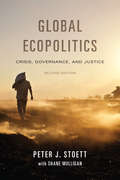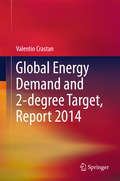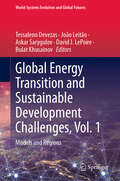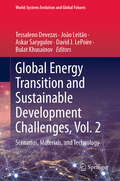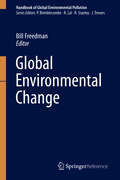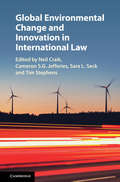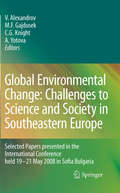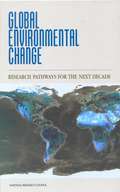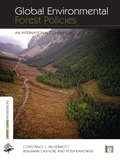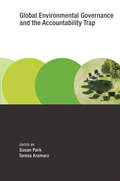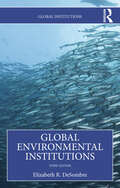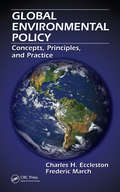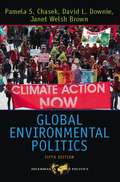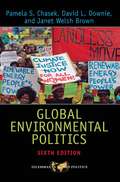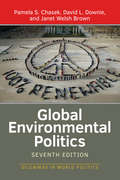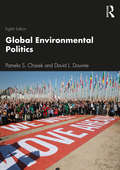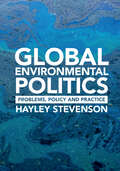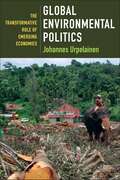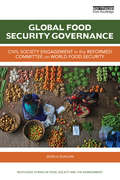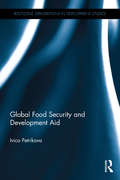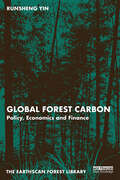- Table View
- List View
Global Ecopolitics: Crisis, Governance, and Justice, Second Edition
by Peter StoettDespite sporadic news coverage of extreme weather events, high-level climate change diplomacy, special UN days of celebration, and popular media references to impending ecological collapse, most students are not exposed to the detailed presentation and analysis of the international relations and diplomacy of environmental policy-making. Comprehensive and accessibly written for first-year or second-year undergraduates, the second edition of Global Ecopolitics provides students with a panoramic view of the policymakers and the structuring bodies involved in the creation of environmental policies. Detailing a considerable amount of environmental activity since its initial 2012 publication, this up-to-date second edition uses an applicable framework of systemic analysis and important case studies that push students to form their own conclusions about past efforts, present needs, and future directions.
Global Energy Demand and 2-degree Target, Report 2014
by Valentin CrastanThis report takes a neutral and independent point of view in attempting to show concrete ways to achieve the goal of reducing CO2 emissions and limiting global warming to the 2-degree target. It presents an overall picture spanning all key countries. In the report, the temporal evolution of the main parameters is given from 1970 to 2011 for all regions of the world and all G-20 countries, starting from the basic data, gross domestic consumption. The parameters are then extrapolated to 2030, taking into account current trends, local factors and the requirements of the 2-degree climate target. An important basis is the structure of the current energy consumption and energy flows of all regions of the world and all G-20 countries, which is analyzed in the appendix in detail and reproduced as clearly as possible. The reports from climate science make it clear that with a greater level of warming, adaptation is the more expensive option. Compliance with the 2-degree climate target is a challenge, but not impossible. The book is intended not only for the scientific community but also for decision makers in government and industry.
Global Energy Transition and Sustainable Development Challenges, Vol. 1: Models and Regions (World-Systems Evolution and Global Futures)
by João Leitão Tessaleno Devezas Askar Sarygulov David J. LePoire Bulat KhusainovThis two-volume book presents the challenges of the global energy transition, offering a comprehensive exploration of the policies and drivers shaping the pace and trajectory of this transformation. Highlighting regional development, the book shows how different models and scenarios of energy transition emerge. It discusses important factors, such as materials and technologies, shedding light on the opportunities and constraints for the energy transition. Global warming and climate change influenced the change in people’s consciousness and their awareness of the need for more limited use of hydrocarbon resources. Changes in weather conditions, rising sea levels, and destructive climate events such as hurricanes, forest fires, droughts, floods, etc. have become more frequent. Many countries around the world, reacting to these changes, have developed long-term plans to actively replace fossil fuels - gas, oil, and coal with renewable energy sources, mainly solar and wind. However, the low replacement rates observed in the global energy sector over the past 30 years raise the question of how far the decarbonization scenarios and models being implemented by many countries bring us closer to the ultimate goal of creating an economy with a low carbon footprint. Seeking answers, the volumes feature 22 chapters split across the two books, which in detail discuss various aspects of the energy transition and their impact on the sustainability of economic development and the future of energy. This first volume, "Models and Regions," focuses on regional disparities and economic drivers, presenting case studies from different regions in 10 chapters.
Global Energy Transition and Sustainable Development Challenges, Vol. 2: Scenarios, Materials, and Technology (World-Systems Evolution and Global Futures)
by João Leitão Tessaleno Devezas Askar Sarygulov David J. LePoire Bulat KhusainovThis two-volume book presents the challenges of the global energy transition, offering a comprehensive exploration of the policies and drivers shaping the pace and trajectory of this transformation. Highlighting regional development, the book shows how different models and scenarios of energy transition emerge. It discusses important factors, such as materials and technologies, shedding light on the opportunities and constraints for the energy transition. Global warming and climate change influenced the change in people’s consciousness and their awareness of the need for more limited use of hydrocarbon resources. Changes in weather conditions, rising sea levels, and destructive climate events such as hurricanes, forest fires, droughts, floods, etc. have become more frequent. Many countries around the world, reacting to these changes, have developed long-term plans to actively replace fossil fuels - gas, oil, and coal with renewable energy sources, mainly solar and wind. However, the low replacement rates observed in the global energy sector over the past 30 years raise the question of how far the decarbonization scenarios and models being implemented by many countries bring us closer to the ultimate goal of creating an economy with a low carbon footprint. Seeking answers, the volumes feature 22 chapters split across the two books, which in detail discuss various aspects of the energy transition and their impact on the sustainability of economic development and the future of energy. This second volume, "Scenarios, Materials, and Technology," explores mechanisms and technological drivers for a sustainable transition in 12 chapters, from local industries to national economies.
Global Environmental Change
by Bill FreedmanThe handbook Global Environmental Change is intended to serve as a reliable and comprehensive resource to attend the needs of researchers, teachers, students, and professionals working in science and policy aspects relevant to environment and sustainability. Entries in the handbook are arranged by major section, and are extensively cross-referenced to allow users to find related titles in a user-friendly way. The handbook is available as a printed volume and as an on-line reference work.
Global Environmental Change and Innovation in International Law
by Neil Craik Cameron S. Jefferies Sara L. Seck Tim StephensThe challenges to global order posed by rapid environmental change are increasingly recognized as defining features of our time. In this groundbreaking work, the concept of innovation is deployed to explore normative and institutional responses in international law to such environmental change by addressing two fundamental themes: first, whether law can foresee, prevent, and adapt to environmental transformations; and second, whether international legal responses to social, economic, and technological innovation can appropriately reflect the evolving needs of contemporary societies at national and international scales. Using a range of case studies, the contributions to this collection track innovation - descriptively, normatively, and as a process in and of itself - to explain international environmental law's functionality in the Anthropocene. This book should be read by anyone interested in the critical intersection of environmental and international law.
Global Environmental Change: Challenges to Science and Society in Southeastern Europe
by Antoaneta Yotova C. Gregory Knight Martin Felix Gajdusek Vesselin AlexandrovSelected papers from the International Conference "Global Environmental Change: Challenges for Science and Society in South-Eastern Europe" held 19-21 May 2008 in Sofia, Bulgaria. Covers changes in climate, land use, carbon and water cycles, air quality, etc.
Global Environmental Change: Research Pathways for the Next Decade
by National Research CouncilHow can we understand and rise to the environmental challenges of global change? One clear answer is to understand the science of global change, not solely in terms of the processes that control changes in climate and the composition of the atmosphere, but in how ecosystems and human society interact with these changes. In the last two decades of the twentieth century, a number of such research efforts--supported by computer and satellite technology--have been launched. Yet many opportunities for integration remain unexploited, and many fundamental questions remain about the earth's capacity to support a growing human population.This volume encourages a renewed commitment to understanding global change and sets a direction for research in the decade ahead. Through case studies the book explores what can be learned from the lessons of the past 20 years and what are the outstanding scientific questions. Highlights include: Research imperatives and strategies for investigators in the areas of atmospheric chemistry, climate, ecosystem studies, and human dimensions of global change.The context of climate change, including lessons to be gleaned from paleoclimatology.Human responses to--and forcing of--projected global change. This book offers a comprehensive overview of global change research to date and provides a framework for answering urgent questions.
Global Environmental Constitutionalism
by Erin Daly James R. MayReflecting a global trend, scores of countries have affirmed that their citizens are entitled to healthy air, water, and land and that their constitution should guarantee certain environmental rights. This book examines the increasing recognition that the environment is a proper subject for protection in constitutional texts and for vindication by constitutional courts. This phenomenon, which the authors call environmental constitutionalism, represents the confluence of constitutional law, international law, human rights, and environmental law. National apex and constitutional courts are exhibiting a growing interest in environmental rights, and as courts become more aware of what their peers are doing, this momentum is likely to increase. This book explains why such provisions came into being, how they are expressed, and the extent to which they have been, and might be, enforced judicially. It is a singular resource for evaluating the content of and hope for constitutional environmental rights.
Global Environmental Forest Policies: An International Comparison (The Earthscan Forest Library)
by Constance McDermott Benjamin Cashore Peter KanowskiMarket globalization and the globalization of environmental concerns have spurred demand for greater international accountability for forest stewardship. In response, a range of multi-lateral governmental and non-governmental initiatives have emerged to redefine the rules of global trade, and demand verification of the legality and/or sustainability of forest products originating from within and outside national boundaries. At the same time there is a lack of transparency and shared understanding about the environmental forest policies that already exist within the world's leading forest producing and consuming countries. The result is that many stakeholders have developed perceptions about a country's regulatory environment that are not consistent with what is actually taking place. This book provides a uniquely detailed and systematic comparison of environmental forest policies and enforcement in twenty countries worldwide, covering developed, transition and developing economies. The goal is to enhance global policy learning and promote well-informed and precisely tuned policy solutions.
Global Environmental Governance and the Accountability Trap (Earth System Governance)
by Susan Park Teresa KramarzAn examination of whether accountability mechanisms in global environmental governance that focus on monitoring and enforcement necessarily lead to better governance and better environmental outcomes. The rapid development of global environmental governance has been accompanied by questions of accountability. Efforts to address what has been called “a culture of unaccountability” include greater transparency, public justification for governance decisions, and the establishment of monitoring and enforcement procedures. And yet, as this volume shows, these can lead to an “accountability trap”—a focus on accountability measures rather than improved environmental outcomes. Through analyses and case studies, the contributors consider how accountability is being used within global environmental governance and if the proliferation of accountability tools enables governance to better address global environmental deterioration. Examining public, private, voluntary, and hybrid types of global environmental governance, the volume shows that the different governance goals of the various actors shape the accompanying accountability processes. These goals—from serving constituents to reaping economic benefits—determine to whom and for what the actors must account. After laying out a theoretical framework for its analyses, the book addresses governance in the key areas of climate change, biodiversity, fisheries, and trade and global value chains. The contributors find that normative biases shape accountability processes, and they explore the potential of feedback mechanisms between institutions and accountability rules for enabling better governance and better environmental outcomes. Contributors Graeme Auld, Harro van Asselt, Cristina Balboa, Lieke Brouwer, Lorraine Elliott, Lars H. Gulbrandsen, Aarti Gupta, Teresa Kramarz, Susan Park, Philipp Pattberg, William H. Schaedla, Hamish van der Ven, Oscar Widerberg
Global Environmental Institutions (ISSN)
by Elizabeth R. DeSombreGlobal Environmental Institutions provides the most accessible and succinct overview of the major global institutions attempting to protect the natural environment, describing their creation and operation, decision-making processes, interactions with other institutions, and impact. Fully updated throughout, this third edition maintains the clear structure of previous editions, examining the underlying causes of global environmental problems creation of global environmental institutions effectiveness of action undertaken by these institutions Providing an overview of the United Nations Environment Programme alongside other entities that play important roles in global environmental governance, this book examines institutions by issue area and introduces organizations with a specific focus on protecting endangered species and biodiversity, the atmosphere, the ocean environment, and regulating the transboundary movement of hazardous substances. Drawing on the latest scholarship, and written by an acknowledged expert in the field, this study is essential reading for students of environmental politics and international organizations.
Global Environmental Policy: Concepts, Principles, and Practice
by Charles H. Eccleston Frederic MarchEnvironmental policy is often practiced reactively with each crisis addressed as an isolated event. Focusing on development of proactive policies, Global Environment Policy: Concepts, Principles, and Practice provides the essential scientific and socioeconomic framework for formulating pragmatic and comprehensive environmental policies. It discusse
Global Environmental Politics
by Pamela S. Chasek David L. Downie Janet Welsh BrownWhenGlobal Environmental Politicswas first published, the environment was just emerging as a pivotal issue in traditional international relations. Today, the environment is considered to be a central topic to discussions of international politics, political economy, international organization, and the relationship between foreign and domestic policy. With new and updated case studies throughout, a revised chapter on improving compliance with international environmental regimes, and a new section on environment within the larger context of sustainable development, this classic text is more complete and up-to-date than any survey of international environmental politics on the market. In addition to providing a concise yet comprehensive overview of global environmental issues, the authors have worked to contextualize key topics such as the 2002 World Summit on Sustainable Development, the Kyoto Protocol, the Stockholm Convention on Persistent Organic Pollutants, international forest policy, and the trade, development and environment nexus. Environmental concerns from global warming to biodiversity loss to whaling are seen as challenges to transnational relations, with governments, NGOs, IGOs, and MNCs all involved in the multilateral interaction that is necessary to address the ever-complicated subject of global environmental politics.
Global Environmental Politics
by Pamela S. Chasek David L. Downie Janet Welsh BrownAlthough discussions about the global environment are now a daily occurrence--from companies touting energy-saving products to politicians debating how to best address the issue of climate change and other environmental concerns--it remains a topic plagued by misinformation and ideologically skewed arguments. For more than twenty years, Global Environmental Politics has provided an up-to-date, accurate, and unbiased introduction to the world's most pressing environmental issues, and this new edition continues the tradition. With new material on the latest international environmental regimes, the 2012 UN Conference on Sustainable Development, the challenges of regime implementation, and the impact of the global economic crises on the global environment, the authors offer a comprehensive overview of the environment and international politics. It is vital reading for anyone wishing to understand the current state of the field and to make informed decisions about which policies might best safeguard our environment for the future.
Global Environmental Politics
by Pamela S. Chasek David L. Downie Janet Welsh BrownAlthough discussions about the global environment are now a daily occurrence-from companies touting energy-saving products to politicians debating how to best address the issue of climate change and other environmental concerns-it remains a topic plagued by misinformation and ideologically skewed arguments. For nearly twenty years, Global Environmental Politics has provided an up-to-date, accurate, and unbiased introduction to the world's most pressing environmental issues, and the fifth edition continues this tradition. Offering a comprehensive yet concise overview of the environment and international politics, this updated edition includes new material on the latest international environmental regimes, climate change, the environmental challenges of free trade and globalization, and the growing role of the environment in global security. It is vital reading for anyone wishing to understand the current state of the field and to make informed decisions about which policies might best safeguard our environment for the future.
Global Environmental Politics
by Pamela S. Chasek David L. Downie Janet Welsh BrownAlthough discussions about the global environment are now a daily occurrence--from companies touting energy-saving products to politicians debating how to best address the issue of climate change and other environmental concerns--it remains a topic plagued by misinformation and ideologically skewed arguments. For more than twenty years, Global Environmental Politics has provided an up-to-date, accurate, and unbiased introduction to the world’s most pressing environmental issues, and this new edition continues the tradition. With new material on the latest international environmental regimes, the 2012 UN Conference on Sustainable Development, the challenges of regime implementation, and the impact of the global economic crises on the global environment, the authors offer a comprehensive overview of the environment and international politics. It is vital reading for anyone wishing to understand the current state of the field and to make informed decisions about which policies might best safeguard our environment for the future.
Global Environmental Politics
by Pamela S. Chasek David L. Downie Janet Welsh BrownWhen Global Environmental Politics was first published, the environment was just emerging as a pivotal issue in traditional international relations. Today, the environment is considered to be a central topic to discussions of international politics, political economy, international organization, and the relationship between foreign and domestic policy. With new and updated case studies throughout, a revised chapter on improving compliance with international environmental regimes, and a new section on environment within the larger context of sustainable development, this classic text is more complete and up-to-date than any survey of international environmental politics on the market. In addition to providing a concise yet comprehensive overview of global environmental issues, the authors have worked to contextualize key topics such as the 2002 World Summit on Sustainable Development, the Kyoto Protocol, the Stockholm Convention on Persistent Organic Pollutants, international forest policy, and the trade, development and environment nexus. Environmental concerns from global warming to biodiversity loss to whaling are seen as challenges to transnational relations, with governments, NGOs, IGOs, and MNCs all involved in the multilateral interaction that is necessary to address the ever-complicated subject of global environmental politics.
Global Environmental Politics
by Pamela S. Chasek David L. Downie Janet Welsh BrownFor more than twenty years, Global Environmental Politics has provided an up-to-date, accurate, and unbiased introduction to the world's most pressing environmental issues. This new edition continues this tradition while covering critical new developments in the field. Through case studies on key issues such as climate change, toxic chemicals, and biodiversity loss, the authors detail the development of major environmental regimes. With new material on the adoption of global Sustainable Development Goals and the 2030 Agenda for Sustainable Development; the December 2015 Paris Climate Change conference; and recent meetings of major conventions on desertification, biological diversity, and more; the authors present a comprehensive overview of contemporary international environmental politics. Global Environmental Politics is vital reading for any student wishing to understand the current state of the field and to make informed decisions about which policies might best safeguard our environment for the future.
Global Environmental Politics (Dilemmas In World Politics Ser.)
by Pamela S. Chasek David L. DownieGlobal Environmental Politics has provided an accurate, up-to-date, and unbiased understanding of the world’s most pressing environmental issues for thirty years. The eighth edition continues this practice by covering critical new developments in global environmental politics and policymaking. Updated case studies on key issues such as on climate change, endangered species, ozone depletion, desertification, whaling, hazardous wastes, toxic chemicals, and biodiversity detail the ongoing development of major environmental treaty regimes, and new case studies on mercury and marine biodiversity showcase the challenges of creating new treaties during a period of significant global change. There is also new material on the implementation of the Sustainable Development Goals, the 2030 Agenda for Sustainable Development, trade and environment, and the impact of the COVID-19 pandemic on environmental diplomacy. Updated information about global environmental trends, paradigms, and actors completes this comprehensive introduction to contemporary international environmental politics. Global Environmental Politics is vital reading for students of environmental politics and anyone wishing to understand the current state of the field and to make informed decisions about which policies will best safeguard our environment for the future.
Global Environmental Politics: Problems, Policy and Practice (Routledge Research In Global Environmental Governance Ser.)
by Hayley StevensonConcern about humanity's impact on the planet has never been greater, but what are the drivers of environmental change? This wide-ranging introductory textbook outlines the competing explanations of why environmental problems occur and examines the different political approaches taken to address them. Adopting a case study approach, Hayley Stevenson enables students to gain a detailed understanding of how theories and concepts are applied in practice. Diverse perspectives on a variety of contemporary environmental challenges, from climate change to hazardous waste, as well as various responses, from multilateral diplomacy to consumer-focused campaigns, provide students with an in-depth understanding of the merits and limitations of different forms of political action. Refined on the basis of classroom feedback, features include textboxes, key points, a glossary of key terms, questions, further reading suggestions and supplementary online resources. This lively book is an essential resource for advanced undergraduate and postgraduate courses on global environmental politics and environmental policy.
Global Environmental Politics: The Transformative Role of Emerging Economies
by Johannes UrpelainenEmerging economies have fundamentally transformed global environmental politics. Led by China and India, they increasingly make or break international negotiations, which now require agreement among a large number of governments with widely varied preferences. Emerging economies—which still suffer from widespread poverty and frequently struggle with policy implementation—often feel that Western-led initiatives neglect their needs. What does the global environmental policy landscape look like in the age of a rising Global South?This book explains why emerging economies have come to dominate global environmental politics and examines the implications for future international cooperation. Johannes Urpelainen shows that emerging economies continue to prioritize economic growth and often have limited institutional capacity to contain the environmental destruction that it causes. However, he argues, despite barriers to cooperation, innovative bargaining and institutional design offer a way forward. Bottom-up agreements that respect national sovereignty and invest in capacity building hold more promise than traditional top-down treaties with binding commitments.The book features detailed discussions of attempts to address hazardous chemicals, loss of biodiversity, and climate change; a comparative analysis of China and India; and case studies of nine other emerging economies around the world. Global Environmental Politics is an essential, forward-looking overview of today’s most pressing international issue.
Global Food Security Governance: Civil society engagement in the reformed Committee on World Food Security (Routledge Studies in Food, Society and the Environment)
by Jessica DuncanIn 2007/8 world food prices spiked and global economic crisis set in, leaving hundreds of millions of people unable to access adequate food. The international reaction was swift. In a bid for leadership, the 123 member countries of the United Nations’ Committee on World Food Security (CFS) adopted a series of reforms with the aim of becoming the foremost international, inclusive and intergovernmental platform for food security. Central to the reform was the inclusion of participants (including civil society and the private sector) across all activities of the Committee. Drawing on data collected from policy documents, interviews and participant observation, this book examines the re-organization and functioning of a UN Committee that is coming to be known as a best practice in global governance. Framed by key challenges that plague global governance, the impact and implication of increased civil society engagement are examined by tracing policy negotiations within the CFS, in particular, policy roundtables on smallholder sensitive investment and food price volatility and negotiations on the Voluntary Guidelines on the Responsible Governance of Tenure of Land, Fisheries and Forests in the Context of National Food Security, and the Global Strategic Framework for Food Security and Nutrition. The author shows that through their participation in the Committee, civil society actors are influencing policy outcomes. Yet analysis also reveals that the CFS is being undermined by other actors seeking to gain and maintain influence at the global level. By way of this analysis, this book provides empirically-informed insights into increased participation in global governance processes.
Global Food Security and Development Aid (Routledge Explorations in Development Studies)
by Ivica PetrikovaAt the global level, international actors have repeatedly expressed their desire to end hunger and food insecurity. However, food insecurity has persisted. More analysis is hence needed on the link between continuously high levels of global food insecurity and the ever increasing flow of development aid. Global Food Security and Development Aid investigates the impact that development aid has had on food security in developing countries and includes international case studies on Peru, Ethiopia, India and Vietnam. It examines the effect of development aid in general and the impact of aid divided into different categories based on donor, mechanism and sector to which it is provided. In each examined relationship between aid and food security, particular attention is paid to the potentially intervening role played by the quality of national and/or local governance. The book makes policy recommendations, most importantly that donors should take greater care in considering which types of aid are suitable to which specific countries, localities, and development goals, and account for expected developments in the complex relationship between aid, food security, and governance. This book will be of considerable interest to students, researchers and policy-makers in the areas of development aid and food security.
Global Forest Carbon: Policy, Economics and Finance (The Earthscan Forest Library)
by Runsheng YinThis book addresses the major policy, economic and financial issues encountered in global forest carbon.The global forest sector is expected to play a major role in achieving the Paris Agreement’s temperature targets. Therefore, there is an urgent need to explore practical and promising solutions to the challenges facing carbon accounting and policy assessment as the global community undertakes forest sector actions—including the widely known REDD+ initiative. This book demonstrates how vital it is that we identify appropriate perspectives and formulate approaches to address these challenges in an integrated and effective manner. In doing so, it addresses many of the major issues, including the differential potentials for carbon sequestration within various forest ecosystems as well as for storage within a variety of harvested wood products, the joint production of timber and carbon, and the measurement and impact of forest carbon offsets and credits, results-based payments, and other nationally determined contributions centered differences as well. The book examines regional and country-level case studies from across the world and draws on the author's decades of experience working on forest policy and with the forest sector. Overall, this book highlights the technical and policy issues regarding forest sector carbon emission and removal to build useful perspectives, frameworks, and methods for addressing these issues successfully in the future. It advances the knowledge frontiers of global forest carbon policy, economics and finance as well as the ability to assess the effectiveness, efficiency, and equity of forest climate solutions.This book is essential reading for professionals and policymakers working at the intersection of forest policy, carbon storage and climate change, as well as students and researchers in the fields of forestry, natural resource management, climate change and nature-based solutions.
